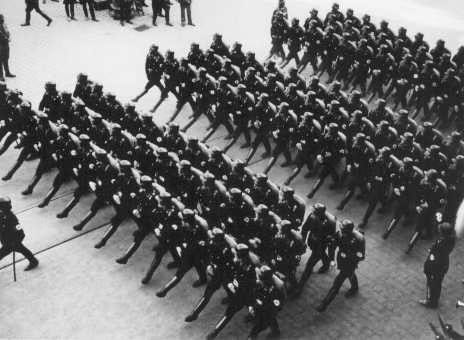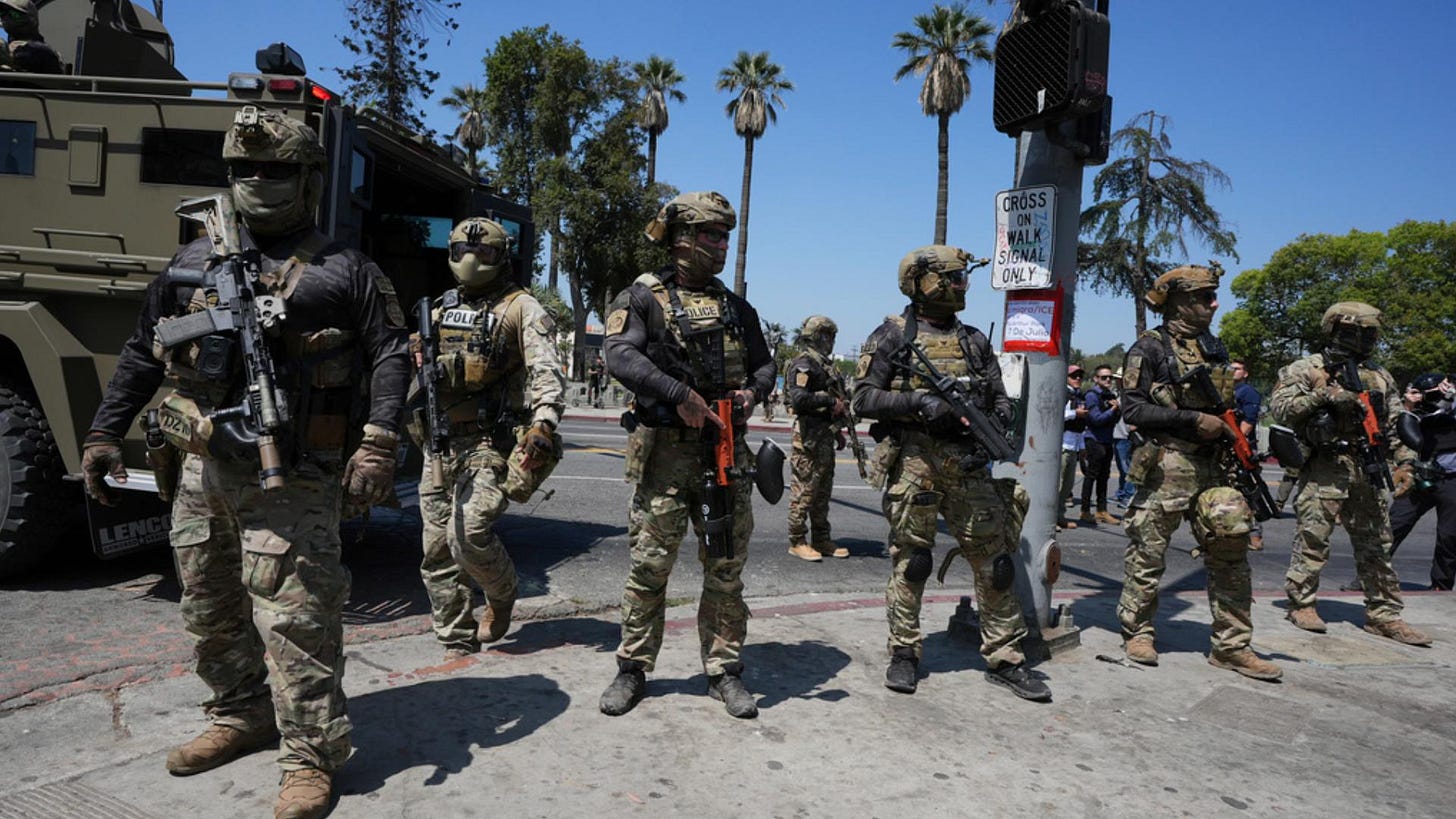When Federal Policing Becomes Regime Policing - A Special Report
From Berlin in 1936 to Washington today: the peril of letting security swallow freedom.
Executive Summary
I don’t write this as an academic. I write it as someone who’s lived inside the system—military, law enforcement, intelligence, federal service. I’ve seen how force consolidates, how “temporary” powers calcify, and how fast the story changes when ideology eclipses law.
This paper examines what happens when policing stops being local and messy and becomes federal, centralized, and loyal to ideology. Nazi Germany is the clearest case study. It didn’t start with ovens. It started with consolidation. The Gestapo (secret state police), the Kripo (criminal police), the Orpo (uniformed order police)—all separate forces at first—were folded together under the SS (Hitler’s original bodyguard) and eventually welded into the RSHA (Reich Security Main Office). Once that happened, there was no dividing line between public safety and political terror. Law enforcement became regime enforcement.
Now see today. ICE is raiding local departments for recruits with $50,000 bonuses and patriotic slogans. DHS keeps building “joint task forces” that blur the lines between federal and local policing. And over it all, the FBI sits as the senior and pre-eminent law enforcement agency, directing these task forces and setting the tone. If a monolithic “Homeland Security Police” emerges, it will almost certainly operate under FBI primacy.
In this paper, I’ll:
Trace how Germany’s police consolidation unfolded and what it enabled.
Show where similar logics are playing out in the U.S. today—recruitment, centralization, erosion of local autonomy.
Lay out three scenarios: best case (federalism holds), probable case (slow erosion into FBI-led centralization), worst case (ideological regime policing).
The goal isn’t hysteria. It’s clarity. When policing consolidates under ideology, it doesn’t defend the Constitution—it rewrites it.
Introduction
I’ve carried the badge, worn the uniform, sat in the rooms where intelligence flows in and decisions get made. I’ve seen how power centralizes in the name of “emergency.” And I’ve learned the hard way that once authority consolidates, it doesn’t give itself back.
That’s why today’s trends set off alarms. ICE luring cops from local departments. DHS spinning up joint task forces. The FBI quietly but firmly running the show as lead agency. This isn’t abstract theory—it’s happening in plain sight.
History doesn’t repeat, but it rhymes. And the rhyme sounds like Germany in the 1930s: fragmented police pulled into federal hands, then welded into a machine that served ideology first and law last. We haven’t crossed that line—but the logic is familiar.
Part I: Police Consolidation in Nazi Germany
Germany in the early 1930s was a patchwork. Policing was fragmented, local, messy. That fragmentation acted as a brake on total control—until it didn’t.
Orpo (Ordnungspolizei), the Order Police. Uniformed cops—traffic control, neighborhood patrols, crowd order.
Kripo (Kriminalpolizei), the Criminal Police. Detectives, case-driven, apolitical in theory.
Gestapo (Geheime Staatspolizei), the Secret State Police. Built in 1933 in Prussia, later handed to Himmler. Mission: neutralize political enemies.
RSHA (Reichssicherheitshauptamt), the Reich Security Main Office. Formed in 1939, merging Gestapo, Kripo, and SS intelligence (the SD). This unified public order, criminal policing, and political terror.
The turning point was 1933–36. After the Reichstag Fire, Hitler declared emergency powers. Himmler absorbed state police into his control. By 1936, as Reichsführer-SS and Chief of German Police, he commanded both Orpo and Kripo. Uniformed cops, detectives, and secret police all answered to the SS.
That’s when ordinary policing collapsed into regime service. Traffic cops guarded ghettos. Detectives investigated “racial crimes.” Policemen escorted deportation trains. The Gestapo alone didn’t have the manpower to terrorize a nation. It needed the Orpo and Kripo, now consolidated under ideology.
The RSHA in 1939 sealed the deal. Police became indistinguishable from political enforcement. Protecting citizens gave way to protecting the state from its own citizens.
Part II: U.S. Trends Toward Federal Policing
We’re not Nazi Germany. But the rhyme is there.
ICE Recruitment
Local cops are being pulled upward. ICE offers signing bonuses, student loan forgiveness, federal perks. The pitch is clear: leave your underfunded department, join the federal mission. That drains already-thin local forces and reorients loyalty toward Washington.
DHS Task Forces
For two decades, DHS has layered federal agencies—ICE, CBP, ATF—into joint task forces with state and local partners. On paper, it’s collaboration. On the ground, the FBI is the senior player, setting direction. Local cops get folded into federal priorities, their autonomy blurred.
The FBI’s Primacy
This part is critical. The FBI isn’t just another agency—it’s the senior law enforcement body in the United States. It runs JTTFs, dictates intelligence priorities, and coordinates federal investigations. If a consolidated Homeland Security Police emerges, it won’t be ICE or DHS at the top. It’ll be the FBI, using the credibility of law enforcement to lead a political security edifice.
Ideological Rhetoric
Recruitment ads and political speeches frame policing as defense against “radical leftists” or “domestic enemies.” That’s not crime control. That’s ideology. Once ideology defines who the enemy is, the machinery of law enforcement shifts from neutral to partisan.
Surveillance Creep
Tools built for counterterrorism are turned inward: protester monitoring, social media tracking, dragnet databases. The German Gestapo thrived on informants and dossiers. The American apparatus is digital—but the logic is the same.
Part III: Scenarios for Consolidation
Best Case
Federalism holds. States resist ICE recruitment and maintain their own policing authority. The FBI remains powerful but checked by courts, civil society, and messy local politics. Federal policing grows, but fragmentation prevents full consolidation.
Probable Case
This is where we’re headed if nothing changes. ICE continues to siphon officers. DHS expands task forces. The FBI cements itself as the default lead for all major policing operations. Local autonomy erodes in practice, even if it survives in law.
Daily life shifts:
Local protests are surveilled under FBI-led JTTFs.
Immigration enforcement stretches deep into the interior.
Municipal cops report upward to federal directives rather than outward to their communities.
It feels normal—just another layer of bureaucracy—but it’s the slow erosion of local control.
Worst Case
A national crisis (fabricated terror attack, assassination, mass unrest) justifies emergency consolidation. A Homeland Security Police is created, merging ICE, CBP, ATF, and local task force officers under FBI leadership. Loyalty tests are explicit. Dissent becomes criminalized. Surveillance unifies into a nationwide dragnet. At that point, we’re living the RSHA rhyme: law enforcement as regime enforcement.
Recommendations
For policymakers: Reinforce state and local autonomy. Block unchecked ICE recruitment. Limit federal funding strings that buy control of local policing.
For civil society: Track recruitment drives. Expose ideological messaging. Challenge surveillance creep in court.
For citizens: Stay engaged in local politics. Run for councils and boards. Refuse to normalize political policing. Document abuses. Protect whistleblowers.
This isn’t about theory—it’s about where the fight actually lives.
Conclusion
Germany shows what happens when fragmented police are absorbed into one centralized, ideological system. By the time the RSHA existed, there was no line between detective, patrolman, and political enforcer. Resistance inside the system was suicide.
The United States isn’t there yet. But ICE recruitment, DHS centralization, and FBI primacy point in that direction. The best case is messy resilience. The probable case is erosion into quiet FBI-led consolidation. The worst case is a Homeland Security Police—public-facing, FBI-driven, ideology-bound.
I’ve lived inside the machinery of power. I know how fast “temporary” becomes permanent, how quickly safeguards are bypassed in the name of crisis. Don’t assume the guardrails will hold on their own. They only hold if ordinary people lean against them.
Because when law enforcement stops protecting citizens from crime and starts protecting the regime from citizens, democracy is already gone.
Support This Work
Why I Opened the Gates
I don’t believe the words I write should be gated. They aren’t a luxury item or a product for the highest bidder. They’re meant for all of us—especially in a time like this, when democracy, spirit, and truth are tested every day.
That’s why every essay, every archive, every reflection is free to read. No paywall. No tiers of access. Just words given openly, because I believe they’re meant to travel farther than my reach.
Why I Still Ask
But writing isn’t weightless. It takes time, energy, tools, and no small measure of fire to keep it alive. If you’ve found meaning here—if these words have given you clarity, courage, or a little light—then I ask you to consider helping me sustain it.
This is not a transaction. It’s participation. A way of saying: this matters, keep going.
Sources:
KOB Albuquerque – “ICE Recruitment Ads Target Albuquerque Law Enforcement” — shows offers of up to $50,000 signing bonus, student loan forgiveness, enhanced retirement etc.
AP News – “ICE Entices New Recruits with Patriotism Pitch and Promise of $50,000 Signing Bonuses” — confirms the bonus + recruitment messaging using patriotic framing.
The Guardian – “US sheriffs decry White House effort to hire away local law enforcement for ICE” — local law enforcement pushing back on ICE recruiting.
Reuters – “Trump administration offers to pay police wages in places that join immigration enforcement” — shows the fiscal incentives via the 287(g) program and how local police salaries and overtime get tied to participation in federal immigration enforcement.
POLITICO — “Trump administration makes it easier to join ICE.” Notes lifted age caps plus incentives; situates hiring within broader enforcement goals.
DHS News Release — “ICE Receives More than 150,000 Applications…” (Sept 16, 2025). Confirms surge in applicants tied to the new recruiting push and funding.
ICE Official — “America Needs You” recruiting page. States up to $50,000 signing bonus, student-loan repayment, premium pay; shows the campaign’s patriotic framing.
DHS News Release — “287(g) Reaches More Than 1,000 Partnerships…” (Sept 17, 2025). Details full reimbursement of salary/benefits for deputized local officers and performance awards.
FBI.gov – “Joint Terrorism Task Forces | Federal Bureau of Investigation” — describes what JTTFs are and that they include dozens of local/state/federal agencies; FBI is lead.
FBI.gov – “Celebrating 45 Years of FBI Joint Terrorism Task Forces” — gives details of how JTTFs began in NY in 1980, how they’ve spread to all 55 FBI Field Offices.
DHS.gov – “Fusion Centers and Joint Terrorism Task Forces” — shows how fusion centers (state/local) complement JTTFs, but the task forces themselves are led by FBI.
ICE.gov – “ICE issues over 1,000 tentative job offers …” — official ICE statement on job offers, bonuses etc.
Inside the FBI Podcast: Joint Terrorism Task Forces
YouTube — this episode marks the 45th anniversary of the JTTF model, explains how they operate, how many field offices have JTTFs, and gives insight into how local/state/federal agencies integrate under FBI leadership.Controversial ICE commercial aims to recruit new officers as operations ramp up.
Latest ICE Recruitment Advertising - Includes overt neo-nazi and nazi script— Regional Dispatches






Getting an overview from the inside, like right here, is vitally important in order to know what to expect, and how to counteract it. There is always something we can do. Some of us can do several things; other times, a whole lot of people can zero in together on one thing. The point: to keep pushing together in the same direction, and keep those guardrails - hedges of protection, checks and balances, even barricades - up. And to my mind, all of these terms are valid, even necessary, though I'm fine if anyone wants to stick to just one.
I have something of a front row seat into the fight for social justice on two work-related fronts, even now, though discretion (not "reticence") keeps me from commenting specifically. There are encouraging signs and warning flags signaling at the same time. And just as the 30 day mark was expiring, soldiers with machine guns have been seen on my commute route. It always starts small. This administration* is testing those guardrails, and looking for every loophole it can find.